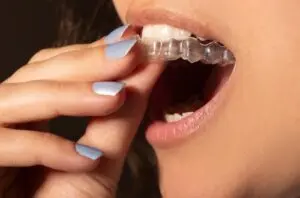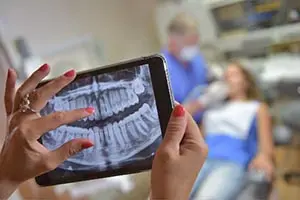Celebrating dental innovation this World Oral Health Day
 The 20th of March 2023 is World Oral Health Day, a special event founded by the FDI World Dental Federation to raise awareness of worldwide oral health issues. Its aim is to empower individuals everywhere with the tools and knowledge to ensure better oral health for all, and World Oral Health Day 2023 focuses on oral wellbeing at every stage of life.
The 20th of March 2023 is World Oral Health Day, a special event founded by the FDI World Dental Federation to raise awareness of worldwide oral health issues. Its aim is to empower individuals everywhere with the tools and knowledge to ensure better oral health for all, and World Oral Health Day 2023 focuses on oral wellbeing at every stage of life.
At Smiles, innovation and technology forms much of the core of what we do best. You don’t have to look far back in history to see just how far dentistry has come. In fact, it wasn’t so long ago that relatively minor oral health issues were considerable risks to general health, and this is something that remains true in communities without access to modern, safe and professional dental care.
The progress made in the world of dentistry has ensured healthier and happier lives for countless people. Researchers, innovators and dental professionals have used their knowledge and discoveries to transform lives from early childhood to our senior years, and dentistry continues to improve with each new discovery.
From ancient roots to the dentistry of today
Dentistry – in one form or another – has been a part of healthcare since ancient times. The Egyptians were drilling teeth as far back as 2900 BCE, supposedly to drain abscesses and alleviate pain. Historians looking into the ancient roots of dentistry have also found evidence of dental implants from 600 BCE in modern day Lebanon, and the Etruscan civilisation were crafting gold dental crowns and rudimentary bridges around the same time.
Throughout South Asia and China, archaeological evidence of silver amalgam fillings have been discovered. Early Arabic physicians developed and practised the science of cleaning and scaling the teeth – it seems we’ve always been concerned with our oral health, no matter when or where around the world.
Knowledge of oral health has developed and grown throughout human history, with new ideas and expertise driving innovation and technology. In the 20th and 21st centuries, oral health truly leapt forward. With the technological advances this era brought, our insight, knowledge and understanding deepened considerably.
Let’s take a closer look at many of the most significant oral health innovations and discoveries from the last century. From new concepts and approaches to everyday oral health to jaw-dropping breakthroughs in dental technology, each one has contributed to healthier and more confident smiles for every stage of life.
Fluoride toothpaste and water fluoridation
Since the beginning of the 20th century, fluoride toothpaste has been the global standard for everyday dental care. It’s something we perhaps now take for granted, but there’s little doubt that this innovation has assisted billions worldwide in improving and maintaining their oral health each day.
The idea of fluoridation arose in an interesting way. American dentist Frederick McKay noticed that patients living in a part of Colorado had almost no tooth decay. After spending years researching why this was the case, McKay was able to show that it came down to a high level of natural fluoride in the drinking water. McKay’s findings led to fluoride being added to drinking water in many parts of the USA in 1945, and several developed countries soon followed suit.
The result? Since fluoridation was introduced, dental caries in children generally decreased by over 50% – it was truly a world-changing decision, and one which has affected how dental care products have been made ever since.
Anaesthesia and painless dentistry
It’s far from comfortable to imagine what dental surgery – even basic dental processes – would have been like prior to the development of anaesthetics.
While dentistry techniques have come such a long way as a result of anaesthetics, dentaphobia remains a common fear – 10% of people surveyed claim to fear the dentists, with many putting off important treatments due to their anxieties. Contemporary sedation methods – which include wearing face masks to inhale gas sedatives or IV sedatives, which involve sedatives being injected – have helped countless uneasy patients undergo important procedures.
The development of lidocaine in the 1940s was a significant milestone in painless dentistry, and it was soon followed by other numbing and nerve-blocking substances. Today, local and safe anaesthesia is absolutely central to modern dentistry. It allows dentists and dental surgeons to undertake operations or procedures in relatively pain-free ways, and provides comfort to anxious or phobic patients who may otherwise suffer unnecessarily.
Dental X-rays
 To say that the X-ray changed modern medicine forever would be something of an understatement. Alongside obvious benefits to healthcare as a whole, X-rays are absolutely essential to orthodontics and a range of dental procedures, too.
To say that the X-ray changed modern medicine forever would be something of an understatement. Alongside obvious benefits to healthcare as a whole, X-rays are absolutely essential to orthodontics and a range of dental procedures, too.
The very first X-ray used in a dental setting was produced in 1896 by Dr. Otto Walkhoff. It took until the 1950s, however, for radiography to become standardised and safe enough to be used regularly in dental procedures. Today, dentists and orthodontists rely on X-ray imagery to make decisions, check for important health issues, plan orthodontic procedures and much, much more.
The electric toothbrush
From twigs wrapped in animal hair to the invention of plastic toothbrushes with nylon bristles and the electric toothbrush, the devices used for cleaning our teeth have changed a lot throughout history. The modern electric toothbrush has its roots in early inventions from the 1920s, when dentists experimented with vibrating and spinning toothbrushes and discovered them highly effective in cleaning teeth. Most dentists nowadays will say that your everyday manual toothbrush is perfectly fine for everyday oral health. However, they’ll also state that electric toothbrushes – by and large – are far more effective at removing plaque, ensuring more complete cleanliness and keeping tooth decay gum disease at bay.
Composite fillings and porcelain crowns
Fillings and crowns have been made with dozens of different substances over the centuries. Some were even made from lead, mercury and other toxic materials – thankfully, they’ve long been superseded by safer substances! Composite resins first began being used for fillings in the 1960s, and the technology rapidly developed to include the tooth-coloured composites we know today. In much the same way, using porcelain for crowns started being used in the middle of the 20th century. This was due to dentists seeking materials which matched durability with aesthetic and discreet qualities.
Intra-oral scanners
Combining cutting-edge optical technology with laser precision, intra-oral scanners are very much a new horizon for image creation in dentistry. This contemporary image generator makes use of detailed scans to create 3D colourised imagery – by capturing 6,000 pictures per second, the level of detail they provide is utterly unmatched. With an intra-oral scanner, clinical precision is advanced and the need to manually create teeth impressions is reduced. These types of scanners, which include iTero scanners, are often used to create implants, crowns, bridges and Invisalign aligners. They’re making dentistry more comfortable and increasing accuracy like never before.
Clear aligners
Good dentistry is all about enduring health matched by comfort and confidence. The field of orthodontics has progressed enormously over the last century, and the past 70 years has seen various innovations that have led us to where we are today. People seeking teeth straightening treatments – and the boost to self esteem and oral health they can result in – have an array of options available to them today. From traditional fixed metal braces to clear aligners, it’s never been easier to obtain a healthier, happier and confident smile.
Invisalign treatments, which are making orthodontics simpler and more comfortable for people across the globe, have signalled a new era of teeth straightening. Durable yet convenient, removable yet effective, they’re a discreet and novel approach that has become enormously popular with teens and adults alike.
Dentistry for a healthier, happier future
It says a lot about the innovative nature of contemporary dentistry that this list is far from exhaustive. We could quite easily have included teeth whitening treatments like Philips ZOOM!, progresses in dental implants and much more. Research continues revealing new approaches to oral wellbeing and dental health, and the years to come are sure to reveal many more discoveries and scientific breakthroughs.
At Smiles Dental, we understand the difference that quality care can make. This World Oral Health Day, join us in celebrating the innovations of the past and looking forward to the future, and supporting the ongoing quest to raise awareness of oral health worldwide. Together, we’ll spread smiles that stretch across the globe.
Dental health is key to wellbeing at all stages in life. Brushing your teeth twice a day, flossing or using interdental brushes, and making regular trips to the dentist or hygienist are central to maintaining excellent oral health.
Find your nearest Smiles Dental practice and book your next appointment if you are due a check-up or need some advice.

